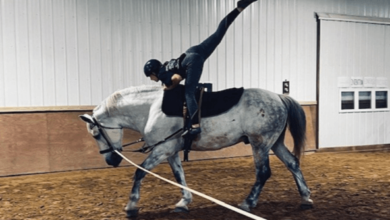How can positive reinforcement be used effectively in horse training?

Introduction to Positive Reinforcement in Horse Training
Positive reinforcement in horse training is a technique where desirable behavior is rewarded to increase the likelihood of that behavior being repeated. This method stands in contrast to traditional training methods that often rely on punishment or negative reinforcement. Positive reinforcement, grounded in the principles of operant conditioning developed by B.F. Skinner, emphasizes the importance of rewarding positive actions to encourage consistent, desired behaviors.
Historically, horse training has often relied on dominance and control. However, as our understanding of animal behavior has evolved, so too have our training methods. Today, many trainers advocate for positive reinforcement as it not only builds a stronger bond between horse and trainer but also makes the training process more enjoyable and effective.
Benefits of Positive Reinforcement
Building Trust
One of the primary benefits of positive reinforcement is the establishment of trust between the horse and the trainer. When a horse learns that positive behavior is consistently rewarded, it begins to trust the trainer and feel more secure in its environment. This trust is crucial for effective training and a harmonious relationship.
Enhancing Communication
Positive reinforcement enhances communication by providing clear and immediate feedback. Horses quickly learn to associate specific actions with rewards, making it easier for them to understand what is expected of them. This clarity helps to reduce confusion and frustration during training sessions.
Reducing Stress
Traditional training methods that rely on punishment can create fear and anxiety in horses. Positive reinforcement, on the other hand, promotes a stress-free learning environment. Horses trained with positive reinforcement are generally more relaxed, willing, and eager to participate in training activities.
Understanding Equine Behavior
Natural Behaviors
To use positive reinforcement effectively, it is essential to understand the natural behaviors of horses. Horses are herd animals with complex social structures and communication methods. They are naturally curious, and their behavior is often driven by instincts such as grazing, exploring, and socializing.
Body Language
Horses communicate primarily through body language. Understanding a horse’s body language is crucial for recognizing when it is relaxed, stressed, curious, or fearful. Key indicators include ear position, tail movement, and posture. Being attuned to these signals allows trainers to adjust their approach accordingly.
Learning Patterns
Horses are quick learners and can be conditioned to associate specific actions with outcomes. They respond well to consistent and repetitive training. Understanding how horses learn helps trainers design effective training sessions that build on previous successes and gradually introduce new challenges.
Getting Started with Positive Reinforcement
Essential Tools
To get started with positive reinforcement, trainers need a few essential tools. These include:
- A clicker or other sound marker to signal the desired behavior.
- Treats or other rewards that the horse finds motivating.
- A training plan with clear, achievable goals.
Initial Steps
Begin by establishing a positive association with the clicker. Click and immediately reward the horse with a treat. Repeat this several times until the horse understands that the click predicts a reward. This process is known as “charging the clicker.”
Setting Goals
Set clear and achievable goals for each training session. Start with simple behaviors and gradually increase the difficulty as the horse becomes more comfortable with the process. Consistent progress helps maintain the horse’s interest and motivation.
Choosing the Right Rewards
Types of Rewards
Choosing the right rewards is critical for effective positive reinforcement. Rewards can be food-based, such as small treats, or non-food-based, like scratches, pats, or verbal praise. The key is to find what the horse finds most motivating.
Food vs. Non-Food Rewards
While food rewards are often the most effective, some horses respond well to non-food rewards. Experiment with different types of rewards to determine what works best for your horse. It’s important to vary the rewards to keep the horse engaged and prevent boredom.
Timing and Consistency
The timing of the reward is crucial. Rewards must be given immediately after the desired behavior to create a clear association. Consistency in rewarding every correct response ensures that the horse understands what is being reinforced.
Techniques for Effective Positive Reinforcement
Clicker Training
Clicker training is a popular method of positive reinforcement. The clicker serves as a marker that indicates the exact moment the desired behavior occurs, followed by a reward. This technique allows for precise communication and helps the horse learn new behaviors quickly.
Target Training
Target training involves teaching the horse to touch or follow a specific object, such as a stick or a hand. This technique can be used to guide the horse through various exercises and is particularly useful for teaching complex behaviors.
Shaping and Luring
Shaping involves reinforcing successive approximations of the desired behavior. This means rewarding small steps that gradually lead to the final behavior. Luring involves using a reward to guide the horse into the desired position or action.
Building Basic Groundwork
Leading and Following
Teaching a horse to lead and follow is fundamental groundwork. Using positive reinforcement, you can reward the horse for walking beside you calmly, stopping when you stop, and turning when you turn.
Haltering
Halter training involves getting the horse comfortable with wearing a halter and being led by it. Rewarding the horse for allowing the halter to be put on and taken off, and for responding to pressure from the lead rope, builds positive associations with these actions.
Desensitization
Desensitization is the process of getting the horse used to various stimuli that might otherwise cause fear or anxiety. Gradually introducing these stimuli and rewarding calm behavior helps the horse learn to cope with different situations.
Training Advanced Behaviors
Tricks and Performance
Positive reinforcement can be used to teach horses a variety of tricks, such as bowing, nodding, or fetching objects. These tricks not only showcase the horse’s intelligence but also strengthen the bond between horse and trainer.
Trail and Obstacles
Training a horse to navigate trails and obstacles can enhance its versatility and confidence. Use positive reinforcement to reward the horse for calmly and accurately traversing different terrains and overcoming various challenges.
Riding Cues
Positive reinforcement is also effective under saddle. Rewarding the horse for responding correctly to riding cues, such as transitions between gaits or changes in direction, helps to solidify these behaviors.
Overcoming Common Challenges
Addressing Fear and Anxiety
Horses can be naturally fearful of new situations or objects. Using positive reinforcement to reward calm behavior helps to reduce fear and build confidence. Gradual exposure and consistent rewards are key to overcoming anxiety.
Managing Frustration
Both horses and trainers can become frustrated during the training process. It’s important to keep training sessions short and to end on a positive note. If frustration arises, take a step back and focus on simpler tasks that the horse can succeed at.
Avoiding Overfeeding
While food rewards are effective, it’s important to manage the horse’s diet to avoid overfeeding. Use small treats and balance training rewards with the horse’s overall nutritional needs.
Maintaining Consistency and Patience
Importance of Routine
Consistency is crucial for successful training. Establishing a routine helps the horse know what to expect and builds a foundation of trust. Consistent training sessions lead to steady progress and a confident horse.
Gradual Progress
Training should progress gradually, with each step building on the previous one. Patience is essential, as rushing the process can lead to setbacks. Celebrate small successes and use them as stepping stones towards more complex behaviors.
Celebrating Small Wins
Every small achievement is a step forward. Recognize and celebrate these wins to maintain motivation and reinforce positive behavior. Small rewards and positive reinforcement create a positive learning environment.
Safety Considerations
Safe Training Environment
Ensure that the training environment is safe for both the horse and the trainer. Remove potential hazards and create a space where the horse can move freely without risk of injury.
Understanding Limits
It’s important to recognize and respect the horse’s physical and mental limits. Pushing a horse too hard can lead to resistance or injury. Pay attention to the horse’s signals and adjust the training pace accordingly.
Preventing Accidents
Preventing accidents involves being aware of the horse’s behavior and environment. Stay vigilant and prepared to respond to unexpected situations. Safety should always be a priority during training.
Integrating Positive Reinforcement with Other Training Methods
Combining Techniques
While positive reinforcement is highly effective, it can be combined with other training methods for a balanced approach. Using a mix of techniques tailored to the horse’s needs can enhance overall training success.
Transition Strategies
Transitioning from traditional methods to positive reinforcement requires careful planning. Gradually introduce positive reinforcement techniques while phasing out reliance on negative reinforcement or punishment.
Balanced Approach
A balanced training approach considers the horse’s individual personality and learning style. Combining positive reinforcement with other methods allows for flexibility and adaptation to various training scenarios.
Case Studies and Success Stories
Real-Life Examples
Numerous success stories highlight the effectiveness of positive reinforcement in horse training. For example, a previously anxious horse can become confident and willing through consistent, reward-based training.
Trainer Testimonials
Experienced trainers often share testimonials about the positive changes they observe in their horses when using reinforcement techniques. These testimonials provide valuable insights and inspiration for others.
Measurable Outcomes
Positive reinforcement leads to measurable outcomes, such as improved performance, increased willingness to work, and stronger bonds between horse and trainer. Tracking these outcomes demonstrates the method’s effectiveness.
Monitoring Progress and Adjusting Techniques
Tracking Improvements
Keep a training journal to track the horse’s progress. Note the behaviors being trained, the rewards used, and the outcomes. Regularly reviewing this journal helps identify patterns and areas for improvement.
Identifying Setbacks
Setbacks are a natural part of the training process. Identifying the causes of setbacks allows for adjustments in techniques and approaches. Patience and adaptability are key to overcoming challenges.
Adapting Strategies
As the horse learns and grows, training strategies may need to be adjusted. Be open to trying new techniques and refining existing ones to meet the horse’s evolving needs.
The Role of the Trainer
Developing Skills
Effective trainers continuously develop their skills and knowledge. Attending workshops, reading literature, and learning from other professionals enhance a trainer’s ability to use positive reinforcement successfully.
Building Rapport
Building rapport with the horse is essential for successful training. Spending time with the horse outside of training sessions, engaging in bonding activities, and understanding the horse’s personality all contribute to a strong relationship.
Continuing Education
Staying informed about the latest research and developments in animal behavior and training techniques ensures that trainers remain effective and humane in their approach. Continuous education is vital for long-term success.
Ethical Considerations
Humane Treatment
Positive reinforcement promotes humane treatment of horses. This approach respects the horse’s well-being and prioritizes its physical and emotional health, fostering a respectful and ethical training environment.
Respect for the Horse
Training should always be conducted with respect for the horse. Understanding the horse’s needs, limits, and natural behaviors ensures that training is both effective and humane.
Promoting Welfare
Positive reinforcement contributes to the overall welfare of the horse. By reducing stress and promoting positive interactions, this method supports a high quality of life for the horse.
Long-Term Benefits of Positive Reinforcement
Sustainable Training
Positive reinforcement creates sustainable training outcomes. Behaviors learned through positive reinforcement are more likely to be retained and repeated, leading to lasting results.
Enhanced Bond
The bond between horse and trainer is significantly enhanced through positive reinforcement. This strong bond is built on trust, respect, and mutual understanding, making training sessions more enjoyable and productive.
Improved Performance
Horses trained with positive reinforcement often demonstrate improved performance. Their willingness to engage and learn leads to better outcomes in various disciplines, from basic groundwork to advanced riding skills.
Common Myths and Misconceptions
Debunking Myths
There are several myths surrounding positive reinforcement, such as the belief that it leads to spoiled or undisciplined horses. In reality, positive reinforcement, when used correctly, promotes disciplined and motivated behavior.

Clarifying Facts
Clarifying facts about positive reinforcement helps to educate the equestrian community. Understanding the principles and benefits of this method encourages more trainers to adopt humane and effective training practices.
Educating the Community
Educating the equestrian community about positive reinforcement fosters a culture of kindness and respect towards horses. Sharing success stories and research findings promotes the adoption of these techniques.
FAQs About Positive Reinforcement in Horse Training
How long does it take for a horse to learn through positive reinforcement? The time it takes for a horse to learn varies based on the individual horse and the behavior being taught. Consistency and patience are key.
Can positive reinforcement be used with all horses? Yes, positive reinforcement can be adapted to suit all horses, regardless of age, breed, or temperament.
What are the most common rewards used in positive reinforcement? Common rewards include food treats, verbal praise, and physical affection like scratching or patting.
Is clicker training necessary for positive reinforcement? Clicker training is a useful tool but not mandatory. The key is to provide a clear and consistent marker for desired behavior.
How can I avoid overfeeding my horse with treats? Use small, low-calorie treats and balance training rewards with the horse’s overall diet to prevent overfeeding.
Can positive reinforcement be used in conjunction with other training methods? Yes, positive reinforcement can be integrated with other training methods for a balanced approach.
Conclusion
Positive reinforcement is a powerful and humane approach to horse training that offers numerous benefits, including building trust, enhancing communication, and reducing stress. By understanding equine behavior, choosing the right rewards, and applying effective techniques, trainers can achieve remarkable results. Whether working on basic groundwork or advanced behaviors, positive reinforcement fosters a positive and productive relationship between horse and trainer. As more equestrians embrace this method, the future of horse training looks promising, with a focus on kindness, respect, and mutual understanding.






